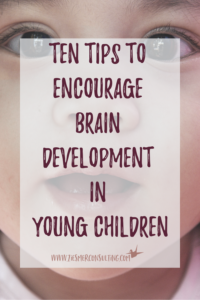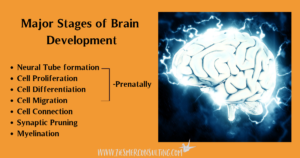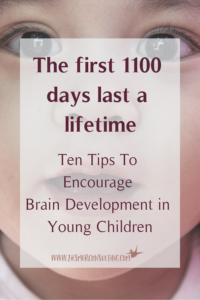 I think a lot about brain development in young children. Yes, I am the person who geeks out over brain research and gets excited at the thought of growing brains in children! I love to see the flicker in their eyes when they make connections.
I think a lot about brain development in young children. Yes, I am the person who geeks out over brain research and gets excited at the thought of growing brains in children! I love to see the flicker in their eyes when they make connections.
Researchers have found that things that happen early in your life leave biological memories in your body. So the phrase “gets under your skin” is very literal!
Stages of Brain Development
We know that there are seven major stages of brain development. We know the first four happen prenatally. But these last three- cell connections, synaptic pruning and myelination. These all happen during the first few years of life.
Synapse formation peaks between 3 and 15 months at the rate of 40,000 per second! That’s a lot of connections! It’s like having an overgrown garden in your brain. So basically a toddler has more connections in their brain than an adult. But they are not smarter than adults. Think about an overgrown garden, if we want it to bear fruit we need to weed it and fertilize it and care for it. A child’s brain is the same.
The synaptic connections are formed based on experiences. When we give babies nurturing, stimulating and positive experiences we are helping their brain grow as well as fertilizing the parts we want stronger.
When babies are first born the area of their brain that gets to work right away is the vision and hearing plot. Babies come out of the womb a crying mess. The don’t know what is going on. They feel the cold air hit them and have no idea what’s happening. They can’t see or hear yet but the brain begins work immediately forming connections to light and sound. It only takes a few weeks for these sense to develop well enough for children to begin to distinguish sounds and see more than shapes.
Once they can see and hear, the next area the works on is language. Around nine months old is when babies really start to learn language. Now, remember babies will learn any language they hear. They can also learn multiple languages. The more language we expose our children to the more they learn.
Two Sides to the Brain Development Coin
Babies brains change structure and function in response to experiences. But there are two sides to this coin. Babies brains can adapt grow as it is exposed to positive experiences. It is also vulnerable and can be harmed by negative experiences and stressors.
Children feel stress as acutely as adults. There are many things that cause this stress. Some are environmental, such as exposure to lead or other environmental hazards. But other experiences, such as not having consistent nurturing care can also become toxic. When our children’s needs are not being met on a consistent basis they can suffer from toxic stress. If a child’s stress response becomes constant, those are the synapses that grow and flourish. There are chemical reactions in the body that happen when you are dealing with stress. The effects can come out in greater health risks as the child becomes an adult.
Interestingly, the areas of our brains that are impacted the most buy anxiety and fear are THE SAME areas that control memory and learning. So when a child is experiencing stress their brain is dealing with the effects of the stress and is not learning the way it should be learning.
So, what can we do to ensure children are thriving with healthy brain development? Here are some tips.
Ten tips to encourage brain development
- Show your baby love and affection. When your baby cries, pick them up. Teach them to trust that you will meet their needs. Change their diaper, feed them, snuggle with them. Smile and coo at your baby and let them know how much you love them. Reassure and calm them when they cry.
- Interact with your baby during feeding time. It doesn’t matter if you breastfeed or bottle feed. Look your baby in the eye. Talk to them, make eye contact frequently. Since it takes a few weeks for a babies eyes to fully develop, it is good to get up close to your baby’s face so they can see you, smell you and hear you.
- Use music to stimulate your baby. Listening to a variety of classical and jazz music is so beneficial for babies. It helps to calm them. Singing is also great for babies and toddlers. Singing simple songs with words that rhyme are entertaining for children.
- Play simple games with your baby. Infants love simple games so peek a boo, motor boat, dancing are good with newborns. Make some sensory bottles and roll them on the floor for mobile infants and toddlers to chase after. Clapping games and movement songs are also favorites with the younger set.
- Change up your routine. This may sound counter intuitive but changing up your routines by sitting a different spots at the dinner table, driving a different route home, or wearing your hair in a different style helps to teach young children that change is good. It makes them less rigid and allows them safe ways to learn resilience.
- Talk and read to your child. Use new and interesting words with children. Give them hands on experiences with them. It is much easier for a child to learn what an aardvark is if they see one at the zoo or in a picture. Recite poetry and rhymes. Encourage conversation and ask questions to keep it going. Research has shown that children should hear an average of 2100 words per hour. So talk, read and sing!
- Provide children a healthy diet. Children need a variety of fresh, whole foods to grow their bodies and their brains. It is important to introduce foods to children several times and in a variety of ways. Sliced or diced, cooked or raw. mixed with other food or alone. Often it takes a few times before children will get used to seeing new foods and willingly eat it.
- Give children a variety of experiences. Take them out in the community and expose them
 to different sights, sounds and smells. Parks and playgrounds are stimulating and fun. Zoo’s, farmers markets, and museums offer a lot for children to look at and take in. Even just going for walks in the neighborhood gives children something new to learn.
to different sights, sounds and smells. Parks and playgrounds are stimulating and fun. Zoo’s, farmers markets, and museums offer a lot for children to look at and take in. Even just going for walks in the neighborhood gives children something new to learn. - Use positive discipline. Behavior guidance is something all children need and will thrive with if done appropriately. Consequences should be developmentally appropriate. Consistency and follow through are key. Children need to have clear expectations that are not always fluctuating. Shaming or frightening children does not teach appropriate behavior. Role model how you want your children to behave.
- Have fun! It is really good for babies and young children to see adults enjoying themselves and having fun. Finding the joy in being with children can boost a child’s self esteem and let’s them see that life is meant to be enjoyed not endured.
The first 1100 days of a baby’s life is the most critical brain building time. Your child is experiencing amazing development and it can be fun and exhilarating to oversee. Enjoy it, savor it and nurture it. To learn more about child development check out my blog and join my facebook page!







Leave a Reply